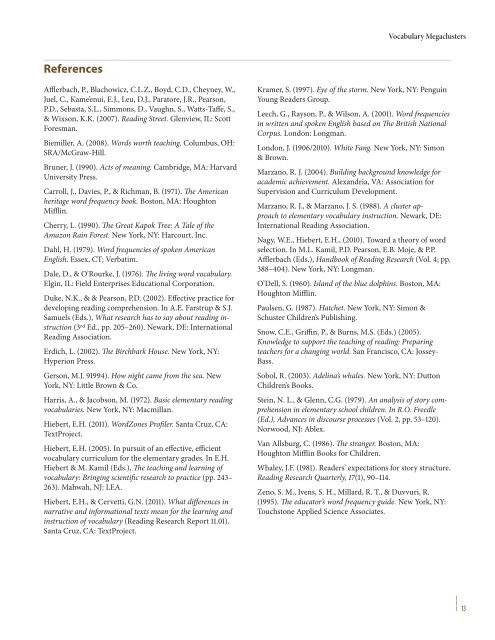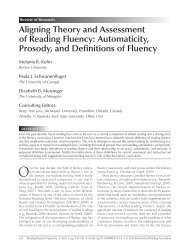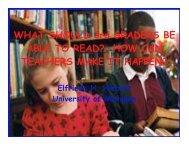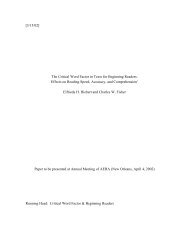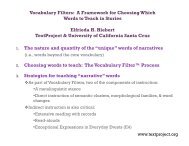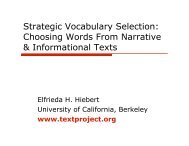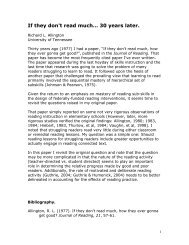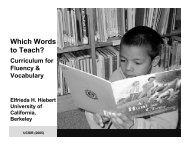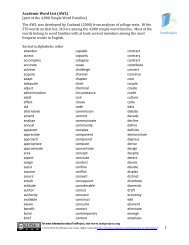Vocabulary Megaclusters - TextProject
Vocabulary Megaclusters - TextProject
Vocabulary Megaclusters - TextProject
You also want an ePaper? Increase the reach of your titles
YUMPU automatically turns print PDFs into web optimized ePapers that Google loves.
<strong>Vocabulary</strong> <strong>Megaclusters</strong>ReferencesAfflerbach, P., Blachowicz, C.L.Z., Boyd, C.D., Cheyney, W.,Juel, C., Kame’enui, E.J., Leu, D.J., Paratore, J.R., Pearson,P.D., Sebasta, S.L., Simmons, D., Vaughn, S., Watts-Taffe, S.,& Wixson, K.K. (2007). Reading Street. Glenview, IL: ScottForesman.Biemiller, A. (2008). Words worth teaching. Columbus, OH:SRA/McGraw-Hill.Bruner, J. (1990). Acts of meaning. Cambridge, MA: HarvardUniversity Press.Carroll, J., Davies, P., & Richman, B. (1971). The Americanheritage word frequency book. Boston, MA: HoughtonMifflin.Cherry, L. (1990). The Great Kapok Tree: A Tale of theAmazon Rain Forest. New York, NY: Harcourt, Inc.Dahl, H. (1979). Word frequencies of spoken AmericanEnglish. Essex, CT: Verbatim.Dale, D., & O’Rourke, J. (1976). The living word vocabulary.Elgin, IL: Field Enterprises Educational Corporation.Duke, N.K., & & Pearson, P.D. (2002). Effective practice fordeveloping reading comprehension. In A.E. Farstrup & S.J.Samuels (Eds.), What research has to say about reading instruction(3rd Ed., pp. 205–260). Newark, DE: InternationalReading Association.Erdich, L. (2002). The Birchbark House. New York, NY:Hyperion Press.Gerson, M.J. 91994). How night came from the sea. NewYork, NY: Little Brown & Co.Harris, A., & Jacobson, M. (1972). Basic elementary readingvocabularies. New York, NY: Macmillan.Hiebert, E.H. (2011). WordZones Profiler. Santa Cruz, CA:<strong>TextProject</strong>.Hiebert, E.H. (2005). In pursuit of an effective, efficientvocabulary curriculum for the elementary grades. In E.H.Hiebert & M. Kamil (Eds.), The teaching and learning ofvocabulary: Bringing scientific research to practice (pp. 243–263). Mahwah, NJ: LEA.Hiebert, E.H., & Cervetti, G.N. (2011). What differences innarrative and informational texts mean for the learning andinstruction of vocabulary (Reading Research Report 11.01).Santa Cruz, CA: <strong>TextProject</strong>.Kramer, S. (1997). Eye of the storm. New York, NY: PenguinYoung Readers Group.Leech, G., Rayson, P., & Wilson, A. (2001). Word frequenciesin written and spoken English based on The British NationalCorpus. London: Longman.London, J. (1906/2010). White Fang. New York, NY: Simon& Brown.Marzano, R. J. (2004). Building background knowledge foracademic achievement. Alexandria, VA: Association forSupervision and Curriculum Development.Marzano, R. J., & Marzano, J. S. (1988). A cluster approachto elementary vocabulary instruction. Newark, DE:International Reading Association.Nagy, W.E., Hiebert, E.H., (2010). Toward a theory of wordselection. In M.L. Kamil, P.D. Pearson, E.B. Moje, & P.P.Afflerbach (Eds.), Handbook of Reading Research (Vol. 4; pp.388–404). New York, NY: Longman.O’Dell, S. (1960). Island of the blue dolphins. Boston, MA:Houghton Mifflin.Paulsen, G. (1987). Hatchet. New York, NY: Simon &Schuster Children’s Publishing.Snow, C.E., Griffin, P., & Burns, M.S. (Eds.) (2005).Knowledge to support the teaching of reading: Preparingteachers for a changing world. San Francisco, CA: Jossey-Bass.Sobol, R. (2003). Adelina’s whales. New York, NY: DuttonChildren’s Books.Stein, N. L., & Glenn, C.G. (1979). An analysis of story comprehensionin elementary school children. In R.O. Freedle(Ed.), Advances in discourse processes (Vol. 2, pp. 53–120).Norwood, NJ: Ablex.Van Allsburg, C. (1986). The stranger. Boston, MA:Houghton Mifflin Books for Children.Whaley, J.F. (1981). Readers’ expectations for story structure.Reading Research Quarterly, 17(1), 90–114.Zeno, S. M., Ivens, S. H., Millard, R. T., & Duvvuri, R.(1995). The educator’s word frequency guide. New York, NY:Touchstone Applied Science Associates.13


